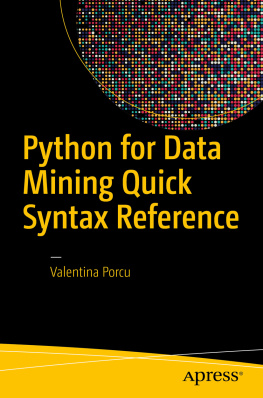,
File and Text OperationsExplains how to deal with files and text processing using built-in Python file objects, many modules from Python's standard library, and platform-specific extensions for rich text I/O. The chapter also covers issues of internationalization and localization, and the specific task of defining interactive textmode command sessions with Python.
,
Persistence and DatabasesIntroduces Python's serialization and persistence mechanisms, as well as Python's interfaces to DBM databases, the Berkeley Database, and relational (SQL-based) databases.
,
Time OperationsCovers how to deal with times and dates in Python, using the standard library and popular extensions.
,
Controlling ExecutionExplains how to achieve advanced execution control in Python, including execution of dynamically generated code and control of garbage-collection operations. The chapter also covers some Python internal types, and the specific issue of registering "clean-up" functions to be executed at programtermination time.
,
Threads and ProcessesCovers Python's functionality for concurrent execution, both via multiple threads running within one process and via multiple processes running on a single machine. The chapter also covers how to access the process's environment, and how to access files via memory-mapping mechanisms.
,
Numeric ProcessingShows Python's features for numeric computations, both in standard library modules and in third-party extension packages; in particular, the chapter covers how to use decimal floating-point numbers instead of the default binary floating-point numbers. The chapter also covers how to get and use pseudorandom and truly random numbers.
,
Array ProcessingCovers built-in and extension packages for array handling, focusing on the traditional Numeric third-party extension, and mentions other, more recently developed alternatives.
,
Tkinter GUIsExplains how to develop graphical user interfaces in Python with the Tkinter package included with the standard Python distribution, and briefly mentions other alternative Python GUI frameworks.
,
Testing, Debugging, and OptimizingDeals with Python tools and approaches that help ensure your programs are correct (i.e., that your programs do what they're meant to do), find and correct errors in your programs, and check and enhance your programs' performance. The chapter also covers the concept of "warning" and the Python library module that deals with it.
Part IV, Network and Web Programming
,
Client-Side Network Protocol ModulesCovers many modules in Python's standard library that help you write network client programs, particularly by dealing with various network protocols from the client side and handling URLs.
,
Sockets and Server-Side Network Protocol ModulesExplains Python's interfaces to low-level network mechanisms (sockets), standard Python library modules that help you write network server programs, and asynchronous (event-driven) network programming with standard modules and the powerful Twisted extension.
,
CGI Scripting and AlternativesCovers the basics of CGI programming, how to perform CGI programming in Python with standard Python library modules, and how to use "cookies" to deal with session-state in HTTP server-side programming. The chapter also mentions many alternatives to CGI programming for server-side web programming through popular Python extensions.
,
MIME and Network EncodingsShows how to process email and other network-structured and encoded documents in Python.
,
Structured Text: HTMLCovers Python library modules that let you process and generate HTML documents.
,
Structured Text: XMLCovers Python library modules and popular extensions that let you process, modify, and generate XML documents.
Part V, Extending and Embedding
,
Extending and Embedding Classic PythonShows how to code Python extension modules using C and other classic compiled languages, how to embed Python in applications coded in such languages, and alternative ways to extend Python and access existing C, C++, and Fortran libraries.
,
Extending and Embedding JythonShows how to use Java classes from the Jython implementation of Python, and how to embed Jython in applications coded in Java.










